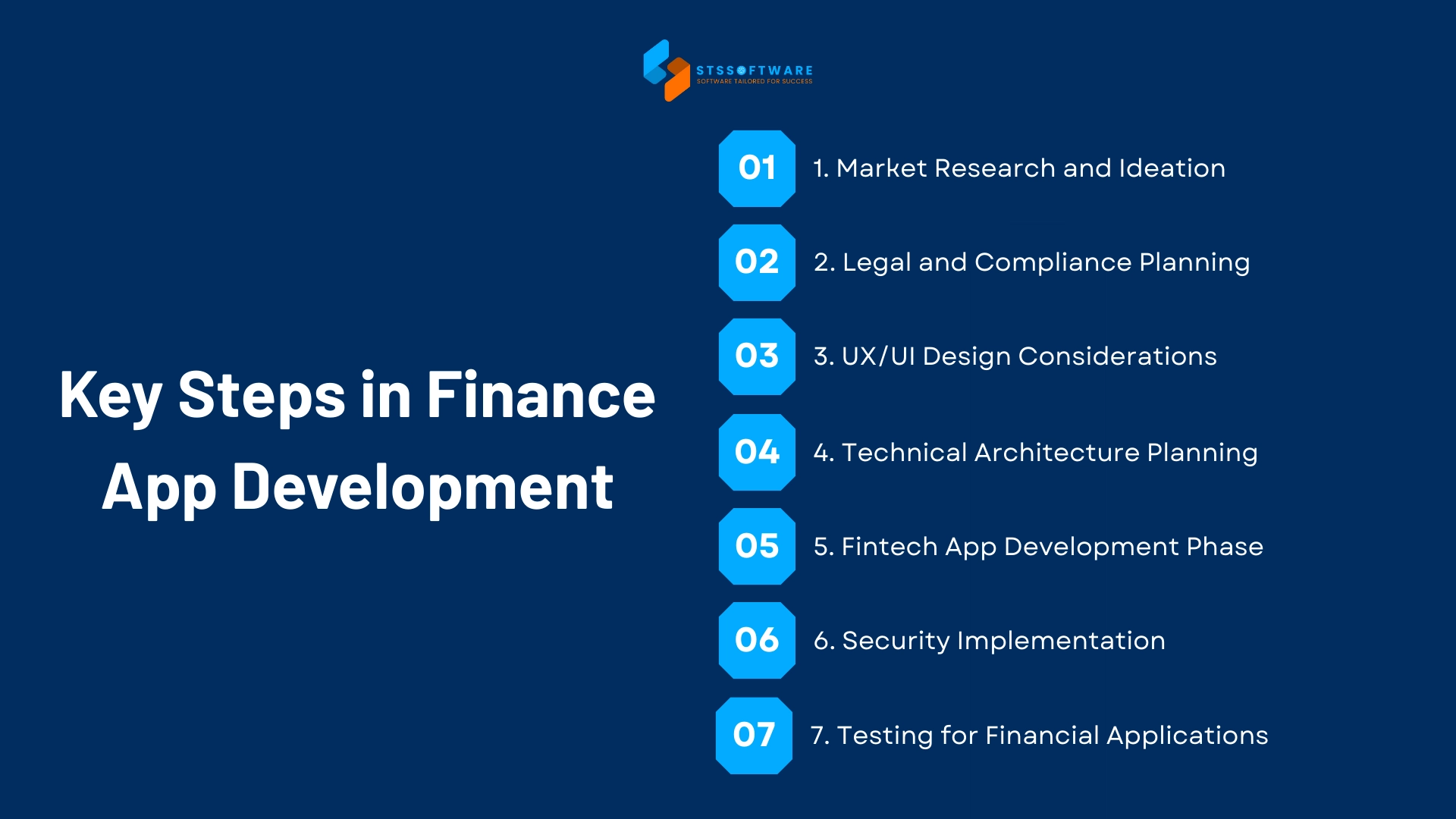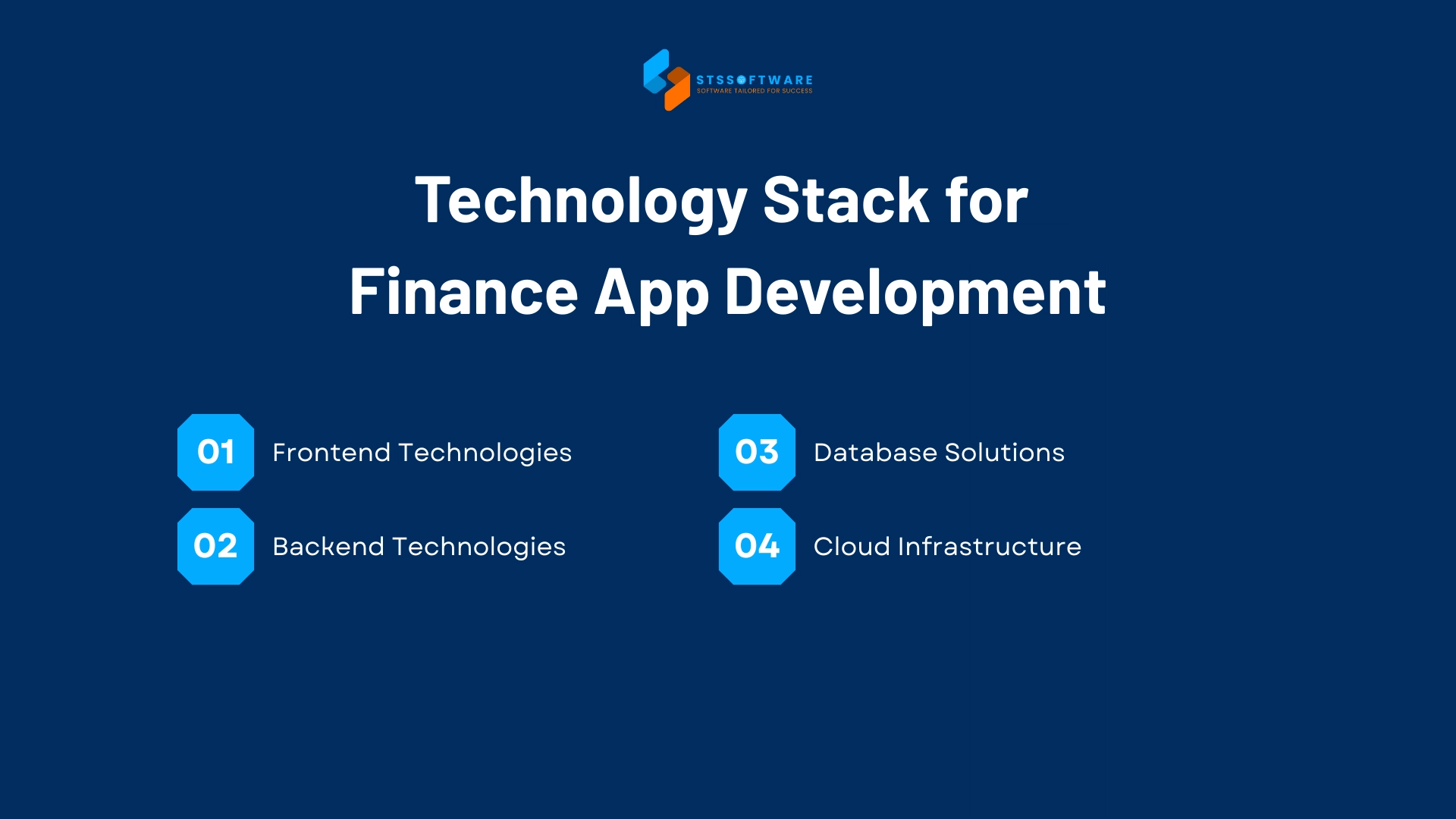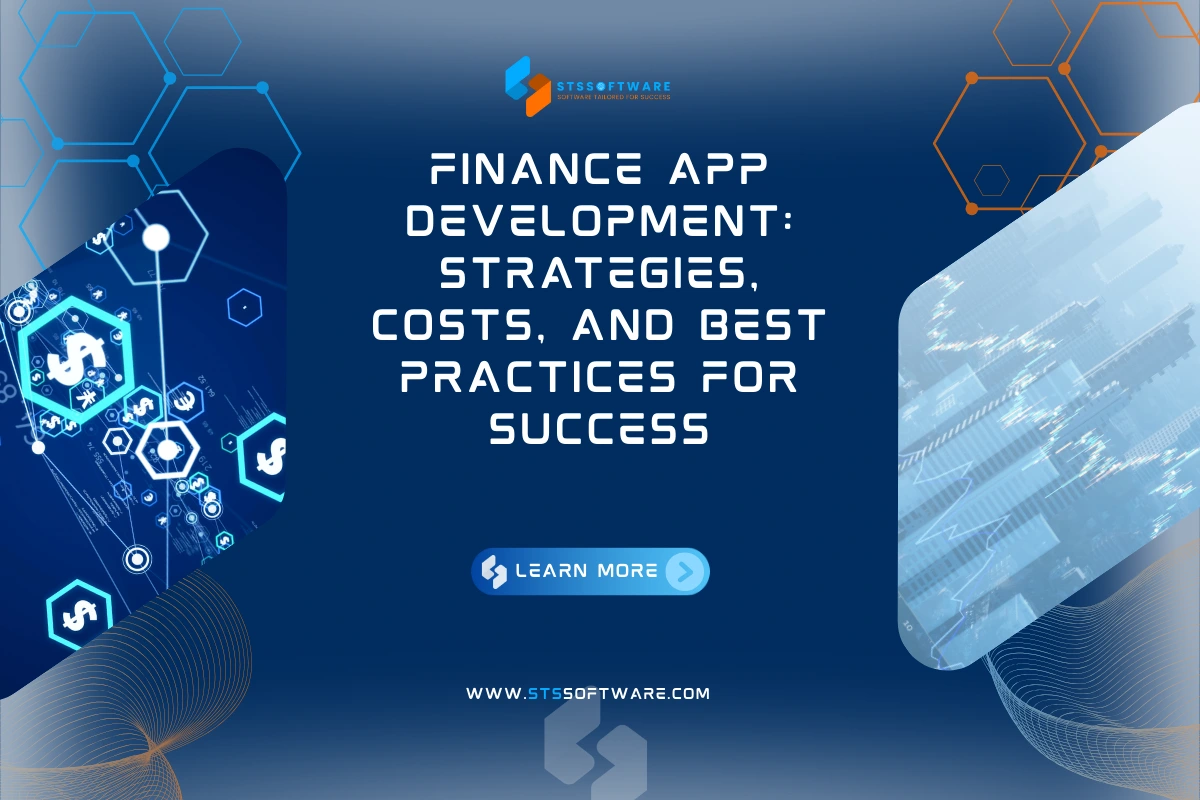Imagine that you’re grabbing coffee, paying with a quick phone tap, and instantly checking your budget. That’s the convenience of finance apps. These apps make managing money simple and fast. Financial technology, or fintech, is changing how people save, spend, and invest. Popular apps like Venmo and Robinhood are proof. In fact, a 2024 Statista report says over 80% of Americans use financial apps for banking, budgeting, or investing. The US fintech market is expected to reach $1.2 trillion by 2027.
Financial apps are replacing traditional banking with easy, user-friendly tools. From mobile banking to robo-advisors, financial mobile app development is giving people more control over their money. But creating a great app takes strategy, smart budgeting, and expertise to stand out. That’s where STS Software shines. As a US-based expert in financial apps development, we build secure, easy-to-use apps that get results.
Understanding Financial App Categories
The world of finance mobile app development is packed with options, each serving unique needs. Let’s break down the main types shaping financial application development today.
- Personal Finance Management Apps help users track spending, set budgets, and plan savings. Think Mint or YNAB, which sync with bank accounts and offer real-time insights. These apps are in high demand, with 65% of Americans using them to manage money, per a 2024 Plaid study. Features like goal tracking and spending alerts drive their popularity.
- Payment and Transfer Apps, like Venmo or PayPal, make sending money smoother. They need secure tech to protect transactions like encryption and tokenization. Integration with banks and compliance with laws are key for financial apps development.
- Investment and Trading Apps let users trade stocks or crypto such as Robinhood or Coinbase. They face tech challenges like real-time data feeds and strict rules from the SEC. Building these requires robust servers and clear user interfaces.
- Banking Apps, like those from Chase or Bank of America, offer account access, transfers, and bill pay. Financial mobile app development here focuses on linking with core banking systems and ensuring top-notch security.
- Insurance Apps streamline claims and policy management (e.g. Progressive’s). Features include document uploads and chat support, making life easier for users.
Each type demands unique skills in financial application development. STS Software specializes in crafting apps that meet these needs.
Key Steps in Finance App Development

Building a financial app that users love takes careful planning and execution. Finance app development involves multiple steps, from brainstorming ideas to testing. Here’s a clear roadmap to guide you through STS Software’s proven approach.
1. Market Research and Ideation
The first step is understanding your audience. Are you targeting young professionals in Austin saving for a house, or retirees in Florida managing investments? Identify their financial needs (budgeting, investing, or quick payments) through surveys or social media insights from platforms like X.
Next, analyze competitors. Apps like Chime or Acorns dominate because they fill market gaps, like fee-free banking or micro-investing. Study their features using tools to spot opportunities. For example, if competitors lack crypto trading, that could be your niche. This research shapes a unique app idea that stands out in the crowded fintech market.
2. Legal and Compliance Planning
Financial application development must follow strict regulations. Laws like the California Consumer Privacy Act (CCPA) protect user data, while the Bank Secrecy Act (BSA) maintains anti-money laundering compliance. If your app operates globally, consider Europe’s PSD2 for payment services or GDPR for data privacy.
Work with legal experts to navigate these rules. Security certifications are also critical for financial mobile app development. They build trust with users and banks. STS Software makes sure every app we build meets these standards, keeping your business compliant and secure.
3. UX/UI Design Considerations
Great design makes or breaks a financial app. In financial apps development, simplicity is key because users want clear, fast access to their money. We follow design principles like minimalism and intuitive navigation. For example, Venmo’s clean interface makes sending cash a snap.
Map out the user journey: a budgeting app might start with account linking, then show a dashboard, and end with spending alerts. Our team uses tools like Figma to create wireframes that prioritize ease of use. Test designs with real users to keep they resonate, especially for diverse groups like Gen Z or small business owners.
4. Technical Architecture Planning
A strong technical foundation powers financial mobile app development. The backend, often built with Node.js or Python, handles user data and transactions. Databases like PostgreSQL store sensitive info securely. API integrations are crucial for bank account linking or Stripe for payments.
It is also important to plan for scalability to handle growth, like when your app goes viral after a TikTok shoutout. STS Software designs architectures that balance speed, security, and flexibility, ensuring your app runs smoothly even during peak usage.
5. Fintech App Development Phase
Choosing the right tech stack is vital for development. For iOS, Swift is a go-to; for Android, Kotlin shines. Cross-platform frameworks like React Native save time for application development.
Agile development methodologies work best for fintech, allowing teams to iterate quickly based on user feedback. Break the project into sprints by building the login feature first, then adding budgeting tools. Regular check-ins keep the project on track.
6. Security Implementation
Security is non-negotiable in our process. We use multi-factor authentication (MFA), like SMS codes or biometrics, to verify users and encrypt data to protect sensitive info, like bank details. Plus, tokenization secures transactions by replacing card numbers with unique codes. Regular security audits catch vulnerabilities early. These measures make users trust your platform with their money.
7. Testing for Financial Applications
Testing ensures your app is reliable. In finance mobile app development, security testing is critical. Penetration tests simulate hacker attacks to find weak spots. Performance testing checks if the app handles thousands of users during a stock market spike. Compliance testing verifies alignment with regulations. Tools like Selenium automate functional tests, while real-world user testing catches UX glitches.
Essential Features for Modern Financial Apps
To win over users, financial mobile app development must deliver features that are secure, easy to use, and packed with value. Here’s what modern financial apps need to have. STS Software’s expertise in financial apps development provides your app with these must-haves to stand out in 2025.
1. Must-have Security Features
Security is the backbone of financial application development. Users expect their money to be safe, especially after high-profile data breaches. Biometric authentication, like fingerprint or face ID, adds a quick, secure way to log in. Apps use this to protect accounts while keeping access simple. Two-factor authentication (2FA), such as a text code or email link, adds another layer of defense. It’s standard for apps to validate only the right user gets in.
Fraud detection systems are critical too. These use AI to spot unusual activity, like a sudden $1,000 transfer from a new device. For example, PayPal’s fraud tools flag suspicious transactions in real time. Compliance with laws also requires secure data handling.
2. User Experience Components
A great user experience (UX) keeps users coming back. In finance app development, dashboard visualization is a game-changer. A clean dashboard shows account balances, spending trends, and goals at a glance. We use charts and graphs to make data pop for busy users checking their phones during lunch breaks.
Financial analytics and reporting take it further, offering insights like monthly spending breakdowns or investment performance that help users plan smarter. Also, notification systems keep users in the loop with real-time alerts for low balances, bill due dates, or suspicious activity.
3. Integration Capabilities
Smooth integrations make apps powerful. Banking APIs connect apps to user bank accounts for real-time data. This lets apps pull transaction details securely. These APIs must comply with banking rules to build trust. Payment gateways enable fast, secure transactions. These need encryption and PCI DSS compliance to protect card data. Credit scoring systems let apps offer credit insights or loan eligibility checks to give users personalized advice.
These essential features are non-negotiable for modern financial apps. They build trust, boost engagement, and make your app a go-to for users. With STS Software’s help, your app will have the tools to compete with fintech giants and delight customers.
Technology Stack for Finance App Development

Choosing the right tech stack sets your app up for success in the fintech industry. It impacts speed, security, and user experience, all vital for winning users. From frontend to cloud, here’s a breakdown of the best tools for financial apps development.
1. Frontend Technologies
The front-end powers what users see in app.
React Native is a popular choice. It lets developers write one codebase for iOS and Android, saving time and money. It’s great for fast updates but may lag for complex animations.
Flutter, backed by Google, is another option. It offers smooth performance and a sleek look, ideal for apps like budgeting tools. However, it has a steeper learning curve.
Native development, swift for iOS, Kotlin for Android, delivers the best speed and polish. But it’s pricier, requiring separate code for each platform. For most startups, React Native balances cost and quality, while native suits big banks.
2. Backend Technologies
The backend handles the heavy lifting in financial application development.
- Node.js is fast and scalable, perfect for real-time apps, where instant transfers are key. It’s lightweight but less suited for heavy computations.
- Python, with frameworks like Django, shines for rapid development and security, ideal for complex apps like investment platforms.
- Java is steady for enterprise apps, with strong security but slower build times. For fintech, Python or Node.js often wins for speed and flexibility.
3. Database Solutions
Financial data needs secure, reliable storage.
SQL databases, like PostgreSQL, are great for structured data, such as transaction records. They provide accuracy to track user spending.
NoSQL databases, like MongoDB, handle unstructured data, like user profiles, and scale well for growing apps.
For financial apps development, SQL is often the go-to for compliance with regulations, but NoSQL suits apps with diverse data. STS Software picks the right database to match your app’s needs.
4. Cloud Infrastructure
Cloud platforms power scalability and security in finance apps.
- AWS offers robust tools for serverless computing and RDS for databases. It’s feature-rich but can be complex.
- Azure, Microsoft’s offer, integrates well with enterprise systems, making it a fit for banking apps.
- Google Cloud is known for AI and data analytics, great for apps with financial forecasting.
All comply with standards, but AWS is the top pick for most fintech due to its flexibility and market dominance.
Finance App Development Cost & Timeline
Launching a financial app is a big investment, but understanding costs and timelines helps you plan smartly. Finance app development involves multiple stages, and ongoing maintenance keeps your app competitive. Here’s what businesses need to know about costs and schedules, with insights from STS Software.
1. Cost Breakdown
Financial app development costs vary by complexity and features. A basic app, like a budgeting tool, might cost $50,000 to $100,000, while a complex app can hit $200,000 to $500,000. Here’s how costs break down across stages:
- Research and Planning: Market analysis and compliance planning cost $5,000 to $15,000. This includes studying competitors.
- Design: UX/UI design, including dashboards and wireframes, runs $10,000 to $30,000.
- Development: Coding the app, APIs, and backend takes the biggest chunk, $30,000 to $200,000. Complex features like fraud detection raise costs.
- Testing: Security and performance tests cost $5,000 to $20,000 to keep compliance with laws.
- Launch: App store setup and marketing add $5,000 to $15,000.
Regional differences matter. In the US, developers in San Francisco charge $80–$150 per hour, while Midwest teams might charge $50–$100. Offshore teams can be cheaper but risk quality and compliance issues. STS Software offers US-based expertise at competitive rates, delivering top-quality finance mobile app development.
2. Timeline Estimation
Building a financial app takes 4 to 12 months, depending on the complexity. Here’s a typical timeline:
- Research and Planning: 2-4 weeks to define features and regulations.
- Design: 4-8 weeks for prototypes and user testing.
- Development: 12-24 weeks, longer for integrations like Plaid or Stripe.
- Testing: 4-8 weeks to catch bugs and ensure security.
- Launch: 2-4 weeks for app store approvals and marketing.
Factors like feature scope (e.g., adding robo-advisors), team size, and revisions can extend timelines. Agile methods, used by STS Software, speed things up by tackling tasks in short sprints, keeping your project on track for users.
3. Maintenance Considerations
After launch, financial apps development requires ongoing care. Maintenance costs 15-20% of initial development annually, from $7,500 to $100,000 for most apps. This covers:
- Updates: New iOS or Android versions need tweaks, costing $2,000–$10,000 yearly.
- Security: Regular audits and patches, run $5,000–$20,000.
- Server Costs: Cloud hosting on AWS or Azure costs $1,000–$10,000 per year.
- Support: User help desks add $2,000–$10,000.
Smart planning for costs, timelines, and maintenance obtains your finance app succeeds. STS Software’s team guides you every step, delivering a high-quality app that wins users nationwide.
Regulatory Compliance and Security Measures
In financial application development, keeping user data safe and following regulations is critical. Users expect apps to be secure and compliant. Here’s how to nail compliance and security with STS Software’s expertise leading the way.
1. Financial Regulations Overview
Finance mobile app development must follow regional rules. In the US, laws like the California Consumer Privacy Act (CCPA) and Bank Secrecy Act (BSA) protect user data and prevent fraud.
The EU’s GDPR sets strict data privacy standards, while Asia’s regulations, like Singapore’s PDPA, vary. To comply, map out requirements early. Use legal experts to create policies and train your team.
2. Data Protection Standards
PCI DSS compliance protects safe card transactions. It requires secure payment gateways and regular checks. Data encryption protects sensitive info, such as bank details. Apps like PayPal use encryption to keep data safe during transfers. STS Software builds these standards into every app, meeting US and global requirements.
3. Security Best Practices
Stay ahead of threats with regular security audits to spot weaknesses. Penetration testing mimics hacker attacks to find gaps. Schedule these quarterly to keep your app secure. Our approach makes sure your finance app development project is safe and trusted by users nationwide.
Why Choose STS Software as Your Partner for Finance App Development
Building a financial app is a big deal, and you need a partner you can trust. STS Software, a US-based leader in finance app development, brings the skills to make your app a hit.
1. Industry Expertise and Experience
STS Software has a strong track record in financial mobile app development. We’ve built apps for budgeting, payments, and banking, helping startups and enterprises shine. With deep fintech knowledge and tech expertise, we have delivered apps that click with users for over 13 years.
2. Security-First Development Approach
Security is our top priority. We follow strict standards like PCI DSS and SOC 2, keeping your app safe from threats. Our secure development lifecycle includes encryption and regular audits, protecting user data like bank details. STS Software’s approach keeps your app trusted by users.
3. Full-Cycle Development Services
We handle every step of financial app development, from brainstorming to app store launch. Need a sleek design or complex APIs? We’ve got you covered. Post-launch, we offer updates and support to keep your app fresh for users.
4. Compliance Knowledge
Navigating regulations is tough, but we know the rules. From the US’s CCPA to Europe’s GDPR, we promise your app complies globally, building trust with users and banks.
5. Long-term Partnership Benefits
STS Software is in it for the long haul. Our maintenance services keep your app secure and fast, while we adapt to new tech like AI analytics. Partner with us to grow your app’s success.
Conclusion
Finance app development is a game-changer for businesses aiming to simplify money management. Looking ahead, fintech is set to soar with trends like AI-driven analytics, blockchain for secure transactions, and open banking integrations. These innovations will shape how people bank, invest, and save.
Ready to launch your app? STS Software’s expertise in the fintech industry makes us the perfect partner. We’ll guide you from concept to launch, delivering a secure, user-friendly app that stands out. Contact STS Software today for a consultation and start building your fintech future!



